|
 Hohenbuehelia nothofaginea Hohenbuehelia nothofaginea
SynonymsHohenbuehelia tristis
Agaricus atrocaeruleus
Pleurotus atrocaeruleus
Agaricus serotinus
Pleurotus serotinus
Agaricus algidus
Pleurotus algidus
BiostatusPresent in region - Indigenous. Endemic
Images (click to enlarge)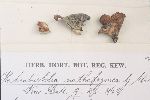
Caption: Image from type, Kew
Owner: B.P. Segedin | 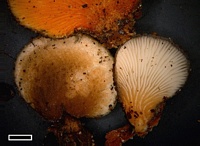
Caption: scale=2mm
Owner: J.A. Cooper | 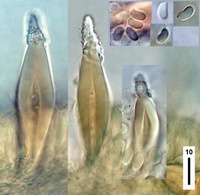
Caption: cystidia and spores
Owner: J.A. Cooper | 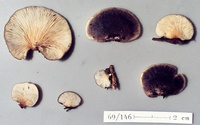
Caption: ZT69-146
Owner: E. Horak: © Creative Commons Attribution-Noncommercial 3.0 New Zealand | 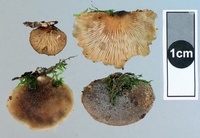
Owner: J.A. Cooper | 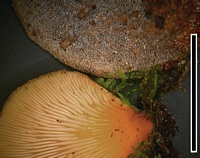
Caption: scale= 1cm
Owner: J.A. Cooper | 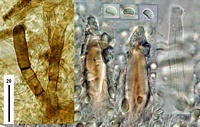
Caption: left: pilocystidia. Middle: metuloid pleurocystidia & spores. Right: thick walled cap hyphae.
Owner: J.A. Cooper | 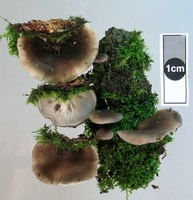
Owner: J.A. Cooper | 
Caption: Fig. 54 | 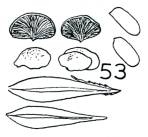
Caption: Fig. 53 | 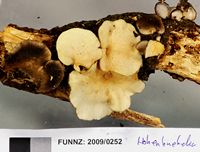
Owner: J.A. Cooper | 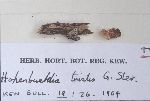
Caption: Type specimen, Kew
Owner: B.P. Segedin | 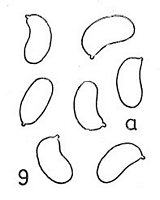
Caption: 9 - Hohenbitehelia aff. nothofaginea: a. spores. | 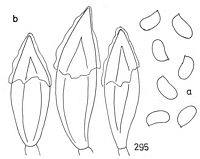
Caption: 295-Hohenbuehelia nothofaginea [Pleurotus serotinus]: a. spores; b. pleurocystidia. |
Article: Stevenson, G. (1964). The Agaricales of New Zealand: V. Kew Bulletin 19(1): 1-59.
Description: Pileus 2-4 x 1.5-3 cm, dark greyish brown, fan-shaped to reniform becoming somewhat lobed, margin strongly down-rolled at first, densely fibrillose, sessile; flesh thin, white, tough. Gills decurrent to the thickened point of attachment, creamy to ochraceous, shallow, moderately thick, very crowded. Spores 6 x 3-3.5µm, non-amyloid. Metuloids very thick-walled, pointed, with or without crystals, very abundant (Fig. 54), Cuticle of loosely woven thin-walled hyphae 4 -5 µm diam., with clamp connections; tomentum of unbranched similar hyphae containing pigment.
Habitat: On fallen dead Nothofagus, Rotoiti, Nelson, 6.6.1955, Stevenson (type).
Notes: This species and the previously described one seem closely related but distinct, and it is presumed that the host range of each is restricted.
Article: Stevenson, G. (1964). The Agaricales of New Zealand: V. Kew Bulletin 19(1): 1-59.
Description: Pileus 1-2 x 1-1.5 cm, buff to sordid, finely fibrillose, fan-shaped, sessile. Gills decurrent to point of attachment, creamy white, shallow, crowded. Spores 7 x 3 µm, non-amyloid, thin-walled. Metuloids 80-90 x 15-20 µm, pseudo-amyloid, very thick-walled, encrusted with crystals, very abundant on gill-faces (Fig. 53). Cuticle of loosely woven hyphae with clamp connections, covered by tufts of parallel thin-walled hyphae 3-8 µm diam., with conspicuous clamp connections.
Habitat: On fallen rotten wood, Levin, 27.10.1947, Stevenson (type).
Article: Horak, E. (1971). A contribution towards the revision of the Agaricales (Fungi) from New Zealand. New Zealand Journal of Botany 9(3): 403-462 (http://www.rsnz.org/publish/abstracts.php).
Notes: Hohenbuehelia tristis Stevenson (29 D) = Hohenbuehelia nothofaginea
Stevenson
Article: Massee, G.E. (1899) [1898]. The fungus flora of New Zealand. Transactions and Proceedings of the New Zealand Institute 31: 282–349 Wellington:.
Description: Pileus at first resupinate, sessile, soon distinctly reflexed and becoming horizontal, obovate or
reniform, downy, rarely almost glabrous, rugulose when dry, due to contraction of the cuticle,
usually blackish-blue, rarely brownish; 2.5-5 cm long, up to 2.5 cm broad; flesh soft, upper
stratum (pellicle) slightly gelatinous, up to 4mm thick, blackish-brown; lower layer (or flesh
proper) thin and whitish; gills at first radiating from a point inside the margin, then
converging towards the base, broad, whitish, at length tinged with yellow; spores 7-8 x 5 µ.
Habitat: On rotten trunks.
Distribution: Dannevirke, New Zealand. Australia, Central Africa, Europe, United States.
Notes: Sessile, gregarious, somewhat imbricated. Smell pleasant. Distinguished by the dusky colour
of the pileus and by the dark-coloured gelatinous cortical layer.
Article: Horak, E. (1971). A contribution towards the revision of the Agaricales (Fungi) from New Zealand. New Zealand Journal of Botany 9(3): 403-462 (http://www.rsnz.org/publish/abstracts.php).
Notes: Of the three collections in Kew, one belongs to Henzicybe Karsten (COLENSO
b 534), while the two remaining collections (COLENSO b 329, b 975) are
conspecific with Hohenbuehelia nothofaginea Stevenson.
Article: Horak, E. (1971). A contribution towards the revision of the Agaricales (Fungi) from New Zealand. New Zealand Journal of Botany 9(3): 403-462 (http://www.rsnz.org/publish/abstracts.php).
Notes: Pleurotus serotinus (Fries) (6) Fig. 25 = Hohenbuehelia nothofaginea Stevenson
After studying this collection (COLENSO b 72) we cannot see any differences
between it and H. nothofaginea, a ubiquous fungus in the beech forests of New
Zealand.
Article: Massee, G.E. (1899) [1898]. The fungus flora of New Zealand. Transactions and Proceedings of the New Zealand Institute 31: 282–349 Wellington:.
Description: Pileus rather fleshy, at first resupinate, then expanded and horizontal, reniform or
semicircular, glabrous, covered with a thin viscid pellicle, reddish-brown, grey, or umber,
sessile or prolonged, behind into a short stem-like base; 1.5-3 cm. across; gills radiating from
the point of attachment of the pileus to the matrix, rather broad, crowded, yellowish ; spores
subglobose, 5-6 p, diameter.
Habitat: On rotten wood, stumps, &c.
Distribution: Dannevirke, New Zealand. Europe, United States, Chili.
Notes: Usually caespitose and imbricated.
Article: Horak, E. (1971). A contribution towards the revision of the Agaricales (Fungi) from New Zealand. New Zealand Journal of Botany 9(3): 403-462 (http://www.rsnz.org/publish/abstracts.php).
Notes: Fig. 2 = Hohenbuehelia aff. nothofaginea Stevenson
The size and dimensions of the microscopical characters found in this collection (COLENSO
1007) are very similar to those of H. nothofaginea Stevenson.
|